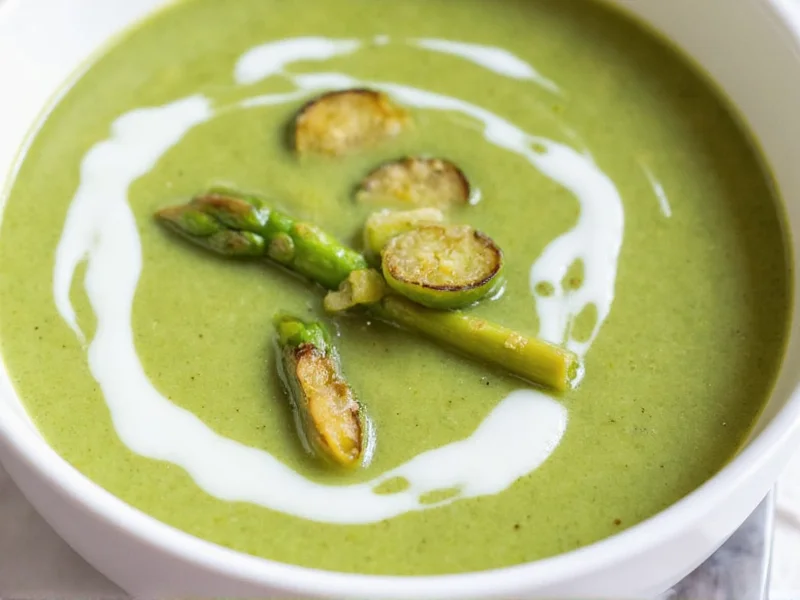The Ultimate Spring Asparagus Soup Recipe
Asparagus soup captures the essence of spring with its vibrant green color and delicate flavor. This recipe has been perfected through years of seasonal cooking, balancing simplicity with gourmet results. Unlike many versions that rely heavily on cream, our approach enhances asparagus's natural sweetness while maintaining a light texture perfect for transitioning seasons.
Why This Asparagus Soup Recipe Works
What makes this recipe stand out among countless asparagus soup variations? The secret lies in three key techniques: proper asparagus preparation, controlled cooking temperature, and strategic flavor layering. Most home cooks either overcook the asparagus (resulting in dull color and muddy flavor) or under-season the broth (creating a bland base). Our method addresses both issues while keeping preparation accessible for cooks of all skill levels.
Essential Ingredients Explained
The quality of your ingredients directly impacts the final soup. Here's why each component matters:
| Ingredient | Why It Matters | Substitution Options |
|---|---|---|
| Fresh asparagus (1.5 lbs) | Provides the soup's essential flavor base and vibrant color | Frozen asparagus (thawed) in off-season |
| Vegetable broth (4 cups) | Creates a clean, neutral foundation that lets asparagus shine | Chicken broth for non-vegetarian version |
| Yellow onion (1 medium) | Adds natural sweetness without overpowering | Shallots for more delicate flavor |
| Garlic (2 cloves) | Enhances depth without dominating | 1/4 tsp garlic powder in pinch |
| Light cream (1/2 cup) | Creates silkiness without heaviness | Coconut milk for dairy-free option |
Equipment You'll Need
- Large pot or Dutch oven (3-4 quart capacity)
- Sharp chef's knife and cutting board
- Vegetable peeler (for asparagus preparation)
- Immersion blender or regular blender
- Fine mesh strainer (optional for ultra-smooth texture)
Step-by-Step Preparation Guide
Preparing the Asparagus
Proper asparagus preparation makes the difference between a good soup and an exceptional one. Start by snapping off the woody ends - hold each spear at both ends and bend until it naturally breaks where the tough portion begins. For the thicker stalks, use a vegetable peeler to remove the tough outer layer from the bottom third. Reserve the trimmed ends for the broth - they contain concentrated flavor.
Cooking Process
- Sauté aromatics: Heat 1 tbsp olive oil in your pot over medium heat. Add diced onion and cook until translucent (about 5 minutes). Add minced garlic and cook for 1 minute until fragrant.
- Add asparagus: Place trimmed asparagus spears and reserved ends in the pot. Stir to coat with aromatics.
- Pour in broth: Add 4 cups vegetable broth and bring to a gentle simmer (do not boil vigorously).
- Cook until tender: Simmer covered for 12-15 minutes until asparagus is fork-tender but still vibrant green.
- Blend carefully: Remove asparagus ends (they've given their flavor), then blend soup with immersion blender until smooth. For extra silky texture, strain through fine mesh.
- Finish with cream: Stir in 1/2 cup light cream and season with salt and white pepper to taste.
Professional Tips for Perfect Asparagus Soup
- Timing is crucial: Overcooking turns asparagus brown and dulls the flavor. Remove from heat as soon as it's tender.
- Acid balance: A squeeze of fresh lemon juice just before serving brightens the flavor profile.
- Texture control: For restaurant-quality smoothness, blend in batches if using a regular blender, and never fill more than halfway with hot liquid.
- Color preservation: Adding a splash of lemon juice to the cooking liquid helps maintain that vibrant green hue.
Delicious Variations to Try
Once you've mastered the basic recipe, experiment with these chef-inspired variations:
Creamy Asparagus Soup Without Cream
For a lighter version that maintains richness, substitute the cream with 1/2 cup cooked white beans blended with the soup. The beans add creaminess and protein while keeping the soup vegan.
Asparagus and Potato Soup
Add 1 medium peeled and diced potato with the asparagus. The potato thickens the soup naturally and adds a subtle sweetness that complements the asparagus beautifully.
Asparagus Soup with Lemon Zest
Grate the zest of one lemon into the finished soup for a bright, citrusy note that enhances the spring vegetable flavors.
Serving Suggestions and Pairings
This versatile soup works as both a starter and a light main course. Consider these presentation ideas:
- Garnish with thin asparagus tips sautéed in butter
- Add a swirl of crème fraîche and fresh chives
- Serve with crusty bread or garlic toast points
- Pair with a simple green salad for a complete meal
- For an elegant touch, top with edible flowers like nasturtiums
Storage and Reheating Instructions
Asparagus soup stores exceptionally well, making it perfect for meal prep:
- Refrigeration: Store in airtight container for up to 4 days
- Freezing: Freeze for up to 3 months (omit cream before freezing; add when reheating)
- Reheating: Warm gently over medium-low heat, stirring frequently. Avoid boiling to preserve color and texture.
Nutritional Benefits
Asparagus isn't just delicious—it's packed with nutrients. One serving (about 1.5 cups) provides:
- Approximately 120 calories
- Excellent source of vitamin K (70% of daily value)
- Good source of folate and vitamin C
- Naturally low in carbohydrates
- Contains prebiotic fibers that support gut health











 浙公网安备
33010002000092号
浙公网安备
33010002000092号 浙B2-20120091-4
浙B2-20120091-4